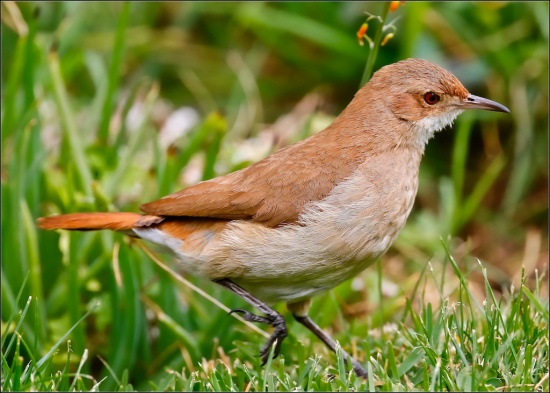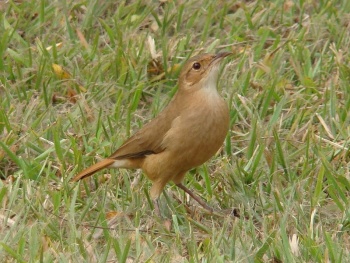
Photo © by Stanley Jones
El 44 Reservation Natural de Tiempo Libre, Capilla del Monte, Argentina, October 2019
- Furnarius rufus
Identification
16–23 cm (6¼-9½ in)
- Rufous overall plumage
- Belly and throat may be paler, but it varies according to the subspecies or even to the individual
- Darker and more reddish tail
- Pale supercilium
Similar Species
The Pale-legged, Wing-banded and Lesser Hornero have a paler and more conspicious eye-brow than the Rufous Hornero. It is easily separated from the Crested Hornero by the lack of a crest.
Distribution
Eastern and central South America: found in Bolivia, Brazil, Paraguay, Uruguay and Argentina.
Taxonomy
Subspecies
Five subspecies are recognized[1]:
- F. r. albogularis:
- South-eastern Brazil (Goiás and Bahia to São Paulo)
- F. r. commersoni:
- F. r. schuhmacheri:
- Northern and eastern Bolivia (La Paz and Beni to Tarija)
- F. r. paraguayae:
- F. r. rufus:
Habitat
Open and semi open areas. Agricultural lands, urban parks and gardens, tropical savanna.
Behaviour
Diet
Their diet consists of insects (e.g. termites or ants) and some other invertebrates, foraged on the ground or under fallen trunks. They can also be seen eating food intended for human consumption.
Breeding
The construct an oven-like nest ("horno" means oven in Spanish), made of straw and manure mixed with mud. The nest can be used again, after some changes, but never for two seasons in a row, so the couple alternate between two or three nests each season. When there is not enough space to build new nests, the pair will build another next to, or even on top of, an older nest. The nests can be occupied by other bird species as well. From this nest is derived the genus name Furnarius, as well as the family name Furnariiidae, from the Latin root for oven.
Action
These birds don't hop, they walk. Sometimes they do it fast, sometimes like that, kind of slow motion and funny. They stop abruptly most of the times.
Vocalisation
The couple usually calls loudly in duets, while vibrating their wings.
In Culture
It is the National Bird of Argentina.
References
- Clements, J. F., T. S. Schulenberg, M. J. Iliff, S. M. Billerman, T. A. Fredericks, B. L. Sullivan, and C. L. Wood. 2019. The eBird/Clements Checklist of Birds of the World: v2019. Downloaded from http://www.birds.cornell.edu/clementschecklist/download/
- Avibase
- BF Member observations
- Remsen, J.V., Jr & Bonan, A. (2020). Rufous Hornero (Furnarius rufus). In: del Hoyo, J., Elliott, A., Sargatal, J., Christie, D.A. & de Juana, E. (eds.). Handbook of the Birds of the World Alive. Lynx Edicions, Barcelona. (retrieved from https://www.hbw.com/node/56394 on 12 January 2020).
Recommended Citation
- BirdForum Opus contributors. (2025) Rufous Hornero. In: BirdForum, the forum for wild birds and birding. Retrieved 2 May 2025 from https://www.birdforum.net/opus/Rufous_Hornero
External Links
GSearch checked for 2020 platform.1





